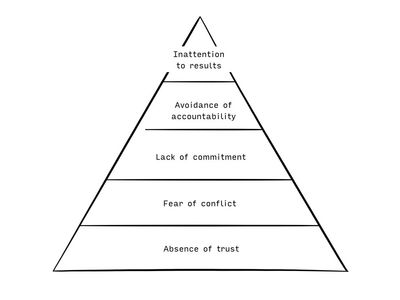Five dysfunctions of a team
Teams deliver – the better the team, the better the performance. We can not think about a team without thinking about performance. Some people being nice to each other and chatting around at the coffee corner does not mean they are a team. They may only be a group of people sharing the same coffee machine but not sharing their goals and rewards.
Good teams find solutions. All, really all of our agile concepts and procedures do not work if they are not backed up by a functioning team.
Patrick Lencioni provides with his „Five Dysfunctions of a Team“ [Lencioni 2002:188] a model to understand how team dysfunctions will build on one another with worsening effects from layer to layer.

See how the dysfunctions will typically be masked by a team in the below table.
| Layer | Dysfunction | Behavioral pattern |
|---|---|---|
| 1 | Absence of trust | Unwilling to be vulnerable within the group |
| 2 | Fear of conflict | Seeking artificial harmony over a constructive passionate debate |
| 3 | Lack of commitment | Feigning buy-in for group decisions creates ambiguity throughout the organization |
| 4 | Avoidance of accountability | Ducking the responsibility to call peers on counterproductive behavior which sets low standards |
| 5 | Inattention to results | Focusing on personal success, status, and ego before team success |
I find the model useful to analyze team dysfunctions, isolate root causes and work through each layer, starting with the most basic and going to the top. E.g., if you can not establish a trustful environment you will not be able to get real commitments.
The dysfunctions can be rephrased to give a positive direction. The below table states what should be achieved by a team on each layer.
| Layer | Try to achieve |
|---|---|
| 1 | Nurturing a trustful environment, allowing oneself to be vulnerable |
| 2 | Have an open and fair communication culture and engage in conflict around ideas |
| 3 | Commit to shared goals and decisions |
| 4 | Hold each other accountable against the shared goals and decisions |
| 5 | Focus on the achievement of collective results |
Lencioni offers a field guide for leaders, managers, and facilitators with exercises and concepts to overcome the five dysfunctions. [Lencioni 2005]
References
- [Lencioni 2002]
- Patrick Lencioni, „The Five Dysfunctions of a Team,“ Jossey-Bass 2002
- [Lencioni 2005]
- Patrick Lencioni, „Overcoming the Five Dysfunctions of a Team: A Field Guide for Leaders, Managers, and Facilitators,“ Jossey-Bass 2005
Comments